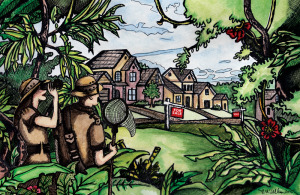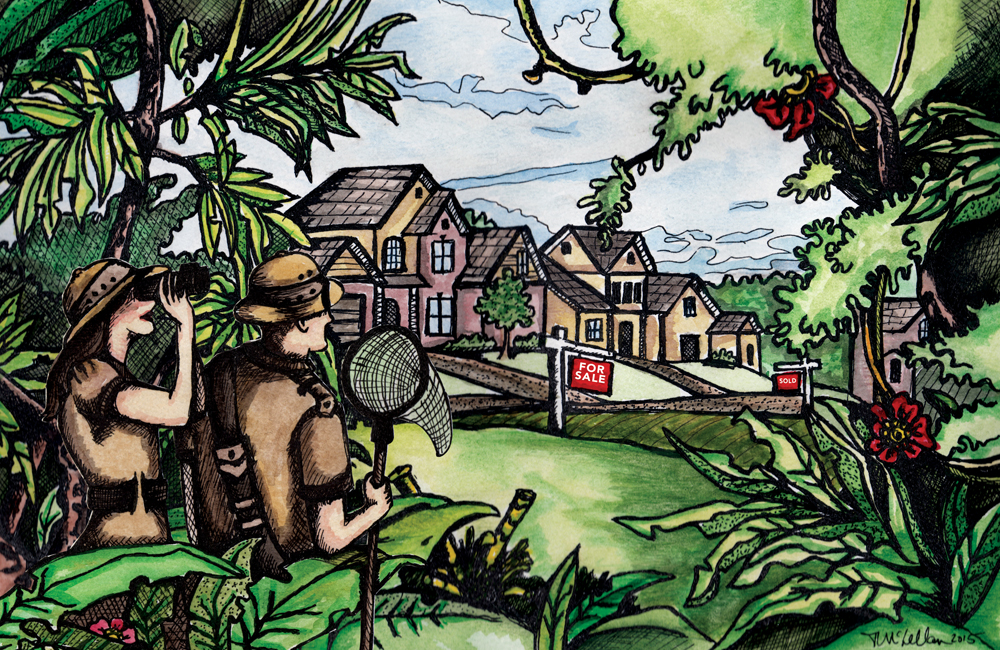Smarter ways to buy and sell your home
stories by Janet Lees ❧ illustration by Tara McLellan
It’s been a long, hard road for the local resale home market since the 2008 recession burst the real estate bubble. Since 2010, area realtors have repeated a common refrain: “slow and steady.” The activity finally seems to be picking up in a meaningful way, and we are firmly in a balanced market, with some areas of the region even tipping into more of a seller’s market for the first time since 2008.
On The Bay asked local realtors to provide insights into today’s market, and to go one step further, offering concrete advice on navigating the complexities of buying and selling real estate in the post-recession, digital age.
The Cold, Hard Facts
Understanding today’s local real estate market
Today’s real estate market is more complex than ever, especially given Southern Georgian Bay’s unique demographics and the impact of technology on buying and selling a home. Here’s a look at how the market is shaping up and some of the issues both buyers and sellers are facing.
Sales are Strong
Area real estate sales in Southern Georgian Bay have been extremely strong, setting back-to-back records in terms of dollars sold in both 2013 and 2014. Total dollar sales of area homes exceeded $600 million in 2014 – the highest dollar figure ever, representing a 9 per cent gain over 2012, according to the Multiple Listing System (MLS) of the Southern Georgian Bay Association of Realtors (SGBAR).
“Despite a dismally slow start to 2014 due to the severe winter weather we experienced last year, the demand for area properties was not impacted,” says Rick Crouch, a broker with Royal LePage Locations North in Collingwood. “The final three-quarters of 2014 saw robust sales activity, resulting in total MLS sales for the year of $705 million – a 12 per cent increase from 2013 and a new annual MLS sales milestone for the area.”
Following a low point in sales during 2009 following the 2008 recession, area real estate activity has steadily rebounded in each of the following years. Since 2011, annual MLS unit sales have increased on average by over five per cent per year. “MLS unit sales in 2014 of 2,208 properties again marked a five per cent increase over the number of MLS sales in 2013 and 19 per cent more than what sold in the dark, post-recession days of 2008.”
Luxury Homes Drive the Numbers Up
“The 2014 increase in MLS dollar sales of 12 per cent compared to the unit sales increase of 5 per cent stems from the fact that we continue to see a strong demand for properties priced in the upper end of the market,” says Crouch. “Many factors help to define the upper end or luxury property market segment; however, from a monetary value we consider any home or condominium priced above $750,000 in our market to be in that category.”
MLS sales in our area above $750,000 in 2014 totaled 79 properties, an increase of 44 per cent over 2013. Similarly, sales over $1 million were up 33 per cent in 2014, with a total of 32 MLS sales reported. “Properties of this value typically take longer to sell, and are often on the market two or three years before attracting a willing buyer,” notes Crouch. “Many buyers in the upper end of the market often prefer to, and have the financial ability to, custom build whatever they want versus buying a resale property that does not fully meet their tastes or needs.”
As a result, this segment of the market also has a much higher level of inventory listed for sale – Crouch estimates that the current number of homes for sale above $750,000 represents a 23-month supply.
It’s a Balanced Market
With the exception of the upper end of the market, 2014 saw an ongoing reduction in the overall amount of available real estate listed for sale. “Strong sales activity combined with a reduction of new MLS listings coming to market resulted in fewer properties for buyers to choose from,” says Crouch.
During 2014, a total of 5,986 new MLS listings came to market, a five per cent reduction in the number of properties listed during the prior year. The number of expired MLS listings also dropped 11 per cent in 2014, “stemming either from old listings finally getting sold or sellers simply choose to remove their unsold properties from the market,” explains Crouch. During 2014, one out of every 2.7 properties listed for sale actually sold, compared to one out of every 3.2 properties listed for sale in 2013. “This overall improvement in the sales-to-listing ratio has resulted in balanced market conditions, levelling the playing field for buyers and sellers alike,” says Crouch.
Condos are Hot
Area condominium sales posted a 19 per cent gain in 2014. “Notwithstanding the fact that many buyers in the area are looking for the maintenance-free lifestyle that condominium living provides, condominiums can offer a more affordable alternative to single-family home ownership, especially for first-time buyers,” explains Crouch.
For example, the average condo sale price in Collingwood in 2014 was $222,450, while the average single-family home in Collingwood sold for $349,900.
Buyers Don’t Have to Buy
To quote Dr. David Foot, author of the seminal book, Boom, Bust Echo, “real estate is affected more by demographics than it is by economics.” This is especially true in Southern Georgian Bay, where today’s real estate buyers are often making a real estate purchase as a discretionary decision versus one of necessity.
“Few are moving here for work purposes,” notes Crouch. “Many are making a purchase here for recreational purposes with, perhaps, a longer term notion of retiring here. The bottom line is, they don’t have to buy anything. They can and often do take months if not years in making a decision to buy. Above all, they do not have to overpay, nor will they.”
Crouch advises sellers to be mindful of pricing their property to ensure it is “in the market” compared to other similar homes that have sold, versus being simply “on the market.”
The Taxman Cometh
Property assessments are an increasingly thorny issue in our area, as homeowners wrestle with ever-increasing tax bills. “I frequently receive calls from consumers questioning or considering an appeal of their property’s assessed value as it relates to their property taxes,” says Crouch, who is a market value appraiser in addition to being a realtor.
“For the most part, property assessments still lag behind their market values, although the gap is narrowing.”
In large residential subdivisions where houses are very similar and there is regular turnover of properties, assessed values closely reflect what houses in those subdivisions are selling for today. However, many high-end waterfront properties and newer custom homes built on rural acreages often reflect current assessments well below their current market values. “Meanwhile, high-priced rural properties often benefit from lower property taxes due to an ongoing agricultural use of the property or in some cases owners have planted trees, thus enabling them to obtain a ‘managed forest’ designation,” explains Crouch. “Both of these factors help to reduce the overall property tax payable.”
HST is Hazy
One of the most confusing aspects of resale real estate – and one often overlooked by sellers, buyers and realtors alike – is Ontario’s Harmonized Sales Tax (HST). HST is usually not applicable on the resale of most residential homes and condominiums, but there are cases where HST is charged.
“Properties that are in a company name or where the owner is an HST registrant may trigger HST being applicable to the sale,” says Crouch. “In our market we have properties where income has been derived such as a farm, a chalet or condominium in a rental program, etc.” In some cases these sales will be subject to HST, which will either be included in or added onto the purchase price.
“With a current HST rate payable of 13 per cent, this can amount to a significant amount of money, so if HST is at all suspect, sellers and buyers are well advised to seek accounting and or legal advice before listing or buying a property,” says Crouch, adding buyers considering registering title of a new property in a company name should also obtain accounting and/or legal advice.
To Rent or Not to Rent
Seasonal rentals have always represented a significant component of the local real estate market. In 2014 a total of 387 rental transactions were processed through the local MLS system.
“Many area property owners and those looking to buy like the notion of renting their property out when it’s not in use to help cover the carrying costs,” notes Crouch. “This is not an issue for annual rentals or for those rentals done for the duration of three or four months during the ski season. There is a growing issue, however, with short-term rentals, those where the tenant is in place for less than 30 consecutive days at a time.”
Short-term rentals of chalets, condos and houses have come under the watchful eye of area municipalities and in some cases condominium corporations. In many cases, municipal zoning does not permit short-term rentals (those less than 30 consecutive days). The Blue Mountains have gone one step further, adopting a Short Term Accommodation (STA) by-law. “Property owners wishing to have their chalet or condo in a rental program which caters to weekend tenants or those looking to stay for a few days or a week must now be licensed,” says Crouch. “Buyers need to be aware of both the rules and the availability of obtaining an STA license before they commit to a purchase.”
Beware of Rent-to-Own Items
“Rent-to-own” items and equipment are being encountered more and more frequently, says Crouch, who is a member of The Ontario Real Estate Association’s Standard Forms Committee which governs such items. “Rental water heaters and water softeners have been common for some time. In recent years, however, we are now seeing instances where furnaces, central air conditioners, air purifiers and other expensive pieces of equipment are of a rent-to-own nature,” says Crouch. He warns that in many cases the rent-to-own agreements can be quite lengthy and often entail hundreds if not thousands of dollars in total payments over the life of the agreement. “Further, many of the rent-to-own agreements do not permit an early buy-out, meaning that a buyer could be stuck with years of payments on a furnace or other item,” says Crouch. “It’s another example of buyer beware, as MLS listings will highlight what will be of a rental or rental-to-own nature in a home or condo – provided of course the listing realtor has done the required due diligence to uncover the facts.”
Technology Has Changed the Game
As with virtually every aspect of our daily lives, technology is playing an increasingly significant role in the way properties are marketed and sold. The MLS platforms used by most real estate boards and associations in Ontario have been modified to allow an increase in the number of photos displayed on a listing. Sellers also now have the ability to post a virtual tour of a property and other online tools.
“First-generation virtual tours were typically done with a digital camera using a ‘fish eye’ lens, which tended to distort the appearance if not the size of a room,” explains Crouch. “New technology has recently emerged that offers much more than just a roving, visually distorted view of a home or condo. Our brokerage has recently entered into an agreement with a company called Planitar to produce what are affectionately called ‘iGuides’ of the properties we list. This process involves using a special laser-enabled camera that scans each room of a house, taking multiple photos and measurements.”
The result is a true visual walk-through complete with integrated floor plans, room measurements, floor areas, and enhanced 360-degree views of the home. Not sure if your grandmother’s antique buffet will fit along a specific wall? Today’s technology will answer that without you ever setting foot in the home.
Technology is also impacting the administrative side of real estate transactions, adds Crouch. “In an area such as ours where many of the buyers and sellers we deal with are from outside the region, the prime mode of communication is often via email. Virtually all real estate documents in the Province of Ontario are now letter size versus legal size, making them perfect for emailing purposes. The final enhancement in our ability to more effectively deal with the flow of paperwork will be the legalization of electronic signatures, which is now winding its way through the provincial legislature.”
Currently, any documents relating to a real estate listing can be executed with a seller’s electronic signature. However, agreements of purchase and sale still have to be signed and initialed by hand. “Once passed into law, electronic signatures will provide for the increased use of tablet computers and other devices,” Crouch predicts, “which will serve to streamline the real estate process for buyers, sellers and realtors alike.”
Navigating today’s real estate market is more complex than ever, so buyers and sellers need to be aware, smart, savvy and informed.















